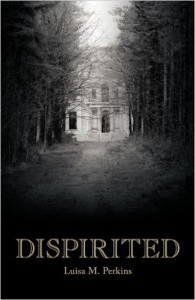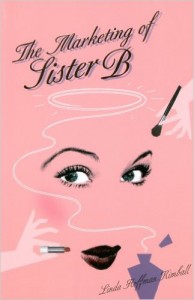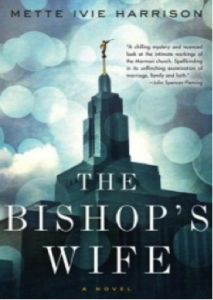This is the seventh and final “New Voices” collection of reviews from Shelah Miner’s Mormon Literature students at BYU-Salt Lake. These three reviews are from the second assignment, reviews of “literary novels” by Mormon authors. The reviewers are Berlyn Davis (Dispirited by Luisa M. Perkins), Courtney Mortensen (The Marketing of Sister B, by Linda Hoffman Kimball), and Allyson Cowdell (The Bishop’s Wife, by Mette Ivie Harrison). Please be encouraging towards the students, most of whom are new to college-level writing assignments.
 Dispirited by Luisa M. Perkins
Dispirited by Luisa M. Perkins
Reviewed by Berlyn Davis
Have you ever wondered what it would be like having your body taken over by another spirit? It is a scary thought. In the book Dispirited, by Mormon author Luisa M. Perkins, a little boy named Blake finds his world changed forever when his body is mysteriously taken over by a demon. He does anything he can to get back into the body that is rightfully his.
The story starts out with Blake crying in his room due to the loss of his mother. Determined to see her again, he finds a way to temporarily separate his spirit from his body. As he leaves his body in search for his dear mother, an evil spirit named Zared takes advantage of the opportunity to steal little Blake’s body for himself. Blake returns unsuccessfully and on top of his disappointment, discovers he is unable to get back into his body due to this demon. Zared taunts Blake and claims he will never get his body back. Blake is devastated and is desperate for anyone to help him in his return to the real world.
About ten years later, the story moves to a new character named Cathy. Her mother married to Blake’s father after her own father was killed in a car accident. She, her sisters, and their new stepbrother Blake, are forced to move from the city to the middle of nowhere due to this new marriage, leaving their old life behind. Cathy, now a senior in high school, is frustrated to have to be the new girl during her last year of school. Her stepbrother Blake, also a senior, is a huge jerk to her too, which doesn’t make things better. Luckily for her, she befriends a neighbor boy named Richard who shows her around the area and hangs out with her at school. She starts to get the hang of this new environment and becomes content with her life. Until strange things start happening.
One day Cathy discovers a small boy named Bunny who seems to be lost. He tells her that he is actually the real Blake and that there is a demon named Zared inside his earthly body. From hearing voices in the bathroom, seeing mirages of old houses from 200 years ago, and now talking to this mysterious little boy, Cathy believes Bunny is telling her the truth and it’s up to her to save him. She tells her friend Richard about all her crazy experiences and he doesn’t believe her, leaving her to figure this mystery out by herself.
I found this book to be very intriguing, and I was pretty interested throughout most of the story. I had low expectations before reading it and by the end I was more awe-struck by it than I thought I would be. It did drag on a little longer than I thought it needed to and it was a little shaky at some parts but overall it kept me engrossed most of the time. It had more strengths than weaknesses. I thought it was a very creative plot and I could totally picture this being an intense movie! It had some great imagery that really made it feel real to me. I fell in love with some of the characters as well. My favorite character would have had to be Cathy. I could totally relate to her. Throughout the book we see everyone wanting something from her. From her mom wanting her to follow her rules, Richard wanting her to pay more attention to her, to Bunny asking her every day to help save him. She got so overwhelmed and stressed out, and it reminded me of how my life is at times.
Another strong character I want to mention is Zared, the evil demon. Even though I absolutely hated him throughout the entire book, he is what made the story entertaining. If he was not there, the plot would be very plain. It was kind of crazy to see a demon in action as well. While in Blake’s body, Zared did so many sinful things (use drugs, porn, etc.), things he couldn’t do in his spiritual state. From my Mormon perspective, it reminded me of the one third of God’s children who chose to follow Satan’s plan, and did not have the opportunity to have a body.
One weaknesses I found was the last half of the book, where Cathy starts her quest in bringing Bunny/Blake back to his true form. During the first half I could not put the book down, I had to keep reading and I was determined to know what happened. However, once I reached the half-way mark, it started to become repetitive and I just wanted it to just cut to the chase already. Finally after reaching the end, it wasn’t anything I expected. I was actually a little shocked that there wasn’t an insanely crazy ending. There were a lot of things that were left unexplained and after getting through all the repetitiveness I was expecting something different. That was the main weakness in my opinion.
Overall I was happy I read this book. Even though it was a little shaky at the end I would still recommend it to anyone who is looking for a good Mormon fiction book. Perkins is a talented author who is very imaginative in her writing. It was fun to get a taste of a new, different story about something I had a little background info about (spirits, and demons, etc). I hope to read more of her stories in the future.
 The Marketing of Sister B, by Linda Hoffman Kimball
The Marketing of Sister B, by Linda Hoffman Kimball
Reviewed by Courtney Mortensen
The Marketing of Sister B follows a “typical” LDS woman – she does her visiting teaching, cooks for her family, volunteers for the PTA, etc. You can tell Donna is bothered that people stereotype her as that average LDS woman, but changes throughout the book. Donna is asked to make “favors” for everyone to take away from a relief society activity, so she concocts a type of essential oil/perfume that smells of cinnamon buns. The oil was a complete hit and a visitor, Lucy, happened to be a marketing agent from a New York City marketing firm. Lucy rushes Donna into a contract to sell her oil just in time for the holiday season. Donna agrees, seeing this as an opportunity to earn money and make a different name for herself. The book follows Donna’s journey through negotiating advertising strategies and battling the worldwide media all while trying to take care of her family and not let her standards slide. She goes from the stereotypical Mormon mom to a nationally known homemaker in a short time, and we experience the struggles and the triumphs along the way.
The humor in this book was definitely on point. In other LDS literature I’ve laughed out loud at presentations of Relief Society extremes and stereotypes, but this book was particularly funny. It included not only ridiculous Relief Society-like comments, but also straight up jokes about the extremes of the society. After making the jokes they would laugh hysterically themselves, making me not feel so bad for laughing at them as well.
There was a nice theme of fellowshipping throughout the story. Donna is a dedicated visiting teacher, and she and her new companion, Juliet, manage to have very individualized visits with the sisters. Donna is also very open to her religion and welcoming to those she meets in her travels. One particular camera woman, Lois, becomes a family friend through talking about their families and experiences, even visiting Donna’s ward at one point.
The relationships Kimball creates in such a short book are great, especially between Donna and her husband Hank. Hank is the guy readers wish existed in their own lives. Through all of the sacrifices he had to make for Donna to pursue her career, he was the happiest trooper. He picked up the slack when she wasn’t around, showed so much outward support to her and their kids, was able to look past a few misunderstandings that happen, etc. He’s just a GREAT guy who loves his wife and will do anything he can for her, and I completely loved him. Donna has great kids who become more and more involved in Donna’s life as the story goes on, and great friends who give her pep talks along the way. On the opposite end, there was a character named Sister Monson who added a weird element to the book. She comes out of the blue in the beginning when Donna first gets noticed and insists to be involved in the whole process in “coaching’ Donna to represent the church in the media. This wouldn’t be weird, but the way Sister Monson handled it was so strange and uncomfortable to me. She disappeared for a while and although I was wondering where she went, I was hoping she wouldn’t be back. She showed up in the end and it was really strange and unnecessary to the story.
Overall I really liked the book. It was an easy read and a good story line. I liked the theme of keeping your standards and being your true self when you are around those with whom you may not agree. Donna learned a lot about herself, and those who stuck with her on the way to fame all came out stronger in the end.
 The Bishop’s Wife, by Mette Ivie Harrison
The Bishop’s Wife, by Mette Ivie Harrison
Reviewed by Allyson Cowdell
Mette Ivie Harrison’s novel The Bishop’s Wife depicts the thrilling mysteries of an LDS ward in Draper, Utah. The protagonist and narrator, Linda Wallheim, has the unofficial and thankless calling as bishop’s wife. This means her husband Kurt will often leave sticky notes on their refrigerator listing names of fellow ward members, and it is her job to bake them some kind of treat and proceed with a checkup on their welfare. It also entails that when distressed ward members like Jared Helm come over to discuss private matters with the bishop, it is up to Linda to take care of his five-year-old daughter. However, it is through these small acts of service that Linda finds herself snooping into members’ private lives. And as it turns out, two men in the ward could potentially be capable of murdering their wives. Linda designates herself as private detective and even child service agent to try and get to the bottom of these mysteries. [Omitting a detailed description of the plot.]
Moving on to the more technical aspects of the novel, I felt the characterization was appropriate in all the right places. There were many secondary characters, who I either hated or loved throughout the whole novel. These were characters of less contribution to the plot, such as Jared’s father Alex, who was a consistent jerk and misogynist; Carrie’s mother Judy, who remained subservient to her husband the whole time; and Linda’s son Samuel, who was the last kid still living with them and was always thoughtful and sweet to Linda. Among the more rounded characters were Jared, who flip-flops from mourning his wife’s disappearance and death to finding a new wife within 2 months of it all; Linda, who tries her best to be Christ-like, but certainly has her moments of spunk when she slaps Carrie’s father across the face or prays to God begging that certain people will be punished in the next life. Finally Carrie, the main victim, is a round character, even though she is missing for most of the novel, because at first she is considered as this poor wife who had to flee her awful marriage and leave her child behind, but actually she is found to be quite selfish and immoral.
This novel’s greatest strength is Harrison’s ability to accurately convey the life of a bishop’s wife (before the murder investigations), and also her ability to intertwine two highly convoluted stories into one novel. Never once were these stories mixed up within each other; Harrison is very skilled at letting the reader know when the shift in murder mysteries occurs. As for conveying what life is like for a bishop’s wife, I could not have been more pleased. While reading, it all sounded so typical. Linda talks about all the meetings her husband is always in, the struggle of always reheating dinners for him, and how her day-to-day life consists of fulfilling the needs of the ward members. My mom was a bishop’s wife as well, so this resonated very closely to me and I found it humorous many times. I also enjoyed the fact that Linda is not a perfect person; she admits when she is stubborn or when she has wronged someone. I felt this showed readers that just because a woman is the bishop’s wife, it doesn’t mean she has it all together. Often times, people seem to place bishops and their families on a pedestal, even though they sin just like everybody else.
Nevertheless, I did find a few weaknesses in this novel. A couple times I felt that the mystery of Carrie Helm dragged too long without any real action taking place. It was moving along too slow, and I grew bored. The action picks up at the end, making for an intense plot twist and resolution, but there were times during the middle that were tedious.
Regardless, I would highly recommend this novel! It contains an intense plot from start to finish, many humorous pokes at the Mormon culture, and a well thought out resolution. There were no total loose ends, while still allowing for the reader to interpret what they choose. I would recommend this novel for advanced young adult readers and up. This is definitely a novel I could picture my grandmother reading by the pool while all the kids swim. It does not require a completely silent environment nor much undivided attention. It is really easy to pick up, as it does not take long for one to become ultimately absorbed into the riveting suspense. It is highly entertaining, while still causing one to turn inward and ponder the fact that people are not always who we assume them to be. There is much more than meets the eye. Linda found that the people she judged the hardest, turned out to be innocent and the people she trusted the most were not so squeaky clean.
